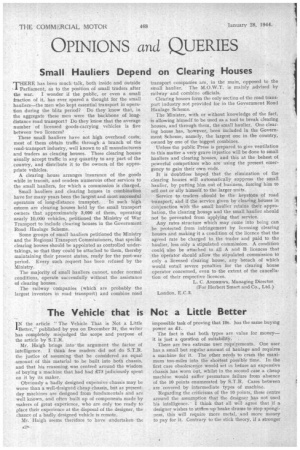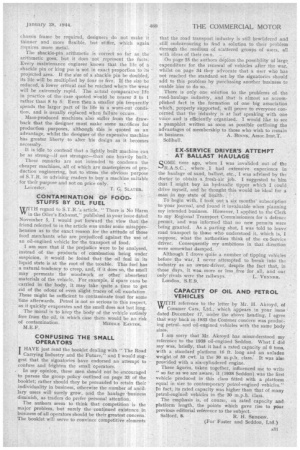The Vehicle that is Not a Little Better
Page 30

Page 33

If you've noticed an error in this article please click here to report it so we can fix it.
I N the article " The Vehicle That is Not a Little Better," published by you on December 31, the writer has completely misjudged the scope and purpose of the article by S.T.R.
Mr. Haigh brings intothe argument the factor of intelligence. I think few readers. did not do S.T.R. the justice of assuming that he considered an equal amount of this material to be built into both chassis, and that his reasoning, was centred around the wisdom of buying a machine that had had £73 judiciously spent on it by its maker.
Obviously a badly designed expensive chassis may be worse than a well-designed cheap chassis,, but as presentday machines are designed from fundamentals and are well known, and often built up of components made by makers of great experience, who are only too ready to place their experience at the disposal of the designer, the chance of a badly designed vehicle is remote.
Mr. '-Haigh seems therefore to have undertaken the A2s impossible task of proving that 19s. has the same buying power as El.
The fact is that both types are value for money— it is just a question of suitability: .
There are two extreme user requirements. One user has a small but regular amount of haulage and requires a machine for it. The .other needs to cram the maximum ton-miles into the shortest possible time. In the first case obsolescence would set in before an expensive chassis has worn out, whilst in the second case a cheap machine would suffer premature failure from absence of the 10 points enumerated by S.T.R. Cases between are covered by intermediate types of machine.
Regarding the criticisms of the 10 points, these centre around the assumption that the designer has not used his intelligence. I think that all will agree that if a designer wishes to stiffen up brake drums to stop sponginess, this will require more metal, and more Money • to pay for it. Contrary to the stick theory, if a stronger chassis frame be required, designers do not make it thinner and more flexible, but stiffer, which again requires more metal.
The shackle-pin arithmetic is correct so far as the arithmetic goes, but it does not represent the facts, Every maintenance engineer knows that the life of a
• shackle pin or king pin is not in exact proportion to its projected area. If the size of a shackle pin be doubled., its life will be multiplied by four or five. If the size be reduced, a lower critical cad be reached where the wear will he extremely rapid. The actual comparative life in practice of the case quoted Wbuld be nearer 3 to I rather than 8 to 5. Even then a smaller pin frequently spends the larger part of its life in a warn-out condition, and is usually replaced when failure occurs.
, Mass-produced machines also suffer from the drawback that the designer must make some sacrifices for production purposes, although this is quoted as an advantage, whilst the designer of the expensive machine has greater liberty to alter his design as it becomes nee essaly It is idle to contend that a lightly built machine can be as strong—if not stronger—than one heavily built.
These remarks are not intended to condemn the cheaper machines, all of which are masterpieces of pro
duction -engineering, but to stress the obvious purpose of S.T.R. in advising readers to buy a machine suitable for their purpose and not on price only.
Leicester. T. Gc. SLATER.
CONTAMINATION OF FOODSTUFFS BY OIL FUEL
WITH regard to S.T.R.'s article, "There is No Harm in the Oiler's Exhaust," published in your issue dated November 5, I would put forward the view that the friend referred to in the article was under some misapprehension as to the exact reason for the attitude of those
food merchants who are prejudiced against the use of an oil-engined vehicle for the transport of food:
I. am sure that if the prejudice were to be analysed, instead of the products of combustion being under suspicion, it would be found that the oil fuel in its liquid state is at the root of the trouble. This fuel has a natural tendency to creep, and, if it does so, the smell may permeate the woodwork or other absorbent materials of the vehicle. For example, if spare cans be carried in the body, it may take quite. a time to get rid of the odour of even slight traces of oil exudation. These might be sufficient to contaminate food for some time afterwards. Petrol is not so serious in this respect, as it quickly evaporates and the smell does not last long.
The moral is to keep the body of the vehicle entirely free from the oil, in which .case there would be no risk
of contamination. MIDDLE 'EASTER. M.E.F.
CONFUSING THE 'SMALL OPERATORS HAVE just read the booklet dealing with " The Road Carrying Industry and the Future," and I would suggest that the signatories have endorsed an attempt to confuse and frighten the small operators.
. In my, opinion, these men should not be encouraged to pursue the group policy outlined on page 33 of the booklet; rather should they be persuaded to retain their individuality in business, otherwise the number of ancillary users will surely grow, and the haulage 'business diminish, as traders do prefer personal attention.
The authors seem to think that competition is the major problem, but surely the continued existence in business of all operators should be their greatest concern. The booklet will serve to convince competitive elements that the road transport industry is still bewildered and still endeavouring to find a solution to their problem through the meditim of saattered groups of users, all with ideas of their own.
On page 25 the authors de'..plore the possibility of large. expenditure for the renewal of vehicles alter the war, whilst on page 34 they advocate that a user who has not reached the standard set by the signatories should add to this problem by purchasing another business to enable him to do so.
There is only one solution to the problems of the road-haulage industry, and that is almost an accomplished fact in the formation of one big association which, properly supported, will prove to everyone concerned that the industry is at last speaking with one voice and is efficiently organized. I would like to see a pamphlet written as soon as possible outlining the advantages of membership to those who wish to remain in business. A. -1BixN5, Assoc.Inst.T. Solih u 11 .
EX-SERVICE DRIVER'S ATTEMPT AT BALLAST HAULAGE
SOME time ago, when I was invalided out of the R.A.S.C., where ,I had extensive experience in the haulage of sand, ballast, etc., I was advised by the doctor to obtain a fresh-air job. I suggested to 'him that I might buy an hydraulic tipper which I could, drive myself, and he thought this would be ideal for a man in my state of health, To begin with, I took out -a six months' subscription to your journal, and found it invaluable when planning my intended business. However, I applied to the Clerk to my Regional Transport Commissioners for a defence permit, and was informed that no new permits were being granted. As a parting shot. I was told to leave road transport to those -who understood it, which is, I suppose, what the authorities think of the ex-Service driver. Consequently my ambitions in that direction were somewhat damped.
Although I drove quite a number of tipping vehicles before the war, I never attempted to break into the industry as an owner-driver, despite the fact that, in those days, it was more or less free for ,all, and our only' rivals were the railways. L. VENNER. London, S.E.9.
CAPACITY OF OIL AND PETROL VEHICLES
wITH reference to the letter by Mr. H. Akroyd, of Commer Cars, Ltd., which appears in your issue dated December 17, under the above heading, I agree that way back in 1933 the Cornmer concern was procluC-. ing petroland oil-engined vehicles with the same body sizes.
I am sorry that Mr. Akroycl has misunderstood my reference to the 1938 oil-engined Seddon. What I did say was, briefly, that it had a rated capacity of 6 tons, with a standard platform 16 ft. long and an unladen weight -of 50 cwt. in the 30 m.p.h. class: It was also provided with a six-cylindered engine.
These figures, taken together, influenced me to write " so far as we are aware, it (1938 Seddon) was the first vehicle produced in this class fitted with a platform equal in size to contemporary petrol-engined vehicles." In fact, its rated capacity was higher than that of 1-nany petrol-engined vehicles in the 30 m.p.h. class.
The emphasis is, of Course, on rated capacity and platform length, the points which gave rise to your previous editorial reference to the subject.
Salford, 8. R. H. SEDDON.
(ForFoster and Seddon, Ltd.)




















































